New IP Phone Fanvil X3S
The last few years in the market of IP-phones one tendency can be clearly seen: most manufacturers seek to increase the range of manufactured devices not by expanding the existing model range, but by increasing the number of model series. Yealink, together with the SIP-T4 series IP phones, continues to successfully produce SIP-T2 series devices. Soon Grandstream will follow this path, adding to the two existing lines of devices also the third model range GXP17XX. Fanvil company is known in Russia, first of all, for its C-series phones, which are distinguished by a successful combination of ergonomics, price and quality. And few people know that in 2014 Fanvil released its first X-series phones: X3 (P) and X5 (G). Meanwhile, the first update has already ripened to this model range - IP-phoneFanvil X3S , which we will talk about today.
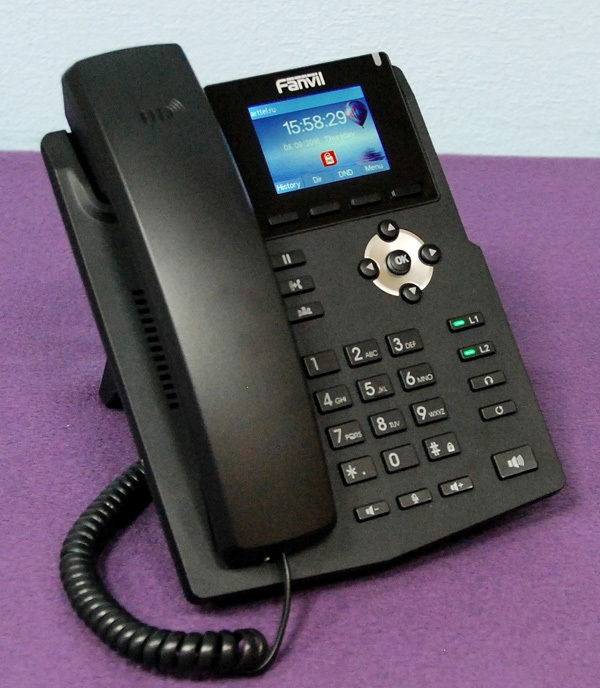
In fact, the update is not limited to the release of one new model. Together with the usual X3S, a modification with PoE - X3SP is also released. Another model - X3G - in addition to supporting PoE and Gigabit Ethernet, will also have a slightly larger display (2.8 inches vs. 2.4 for the first two models). Toward the end of the year, the brand new Fanvil X4 (G) and Fanvil X6 phones are expected to be released, as well as an update of the X5 model. However, everything has its time and we will definitely tell about these phones separately, and today - all the attention of Fanvil X3S.
Fanvil X3S is made in the fashionable style today - the body of dark matte plastic and black glossy edging around the display. This is exactly what almost all modern IP phones produced by Yealink and Grandstream look like, it was not for nothing that I mentioned them at the beginning of the article. However, this style has not yet had time to pall, besides, the designers of Fanvil have added a bit of novelty, almost completely eliminating the white color from the design - even the signatures of the keys are made in light gray. Well, let the Fanvil X3S not differ originality, which has always highlighted the C-series phones, but the device looks, in my opinion, quite nice and concise.
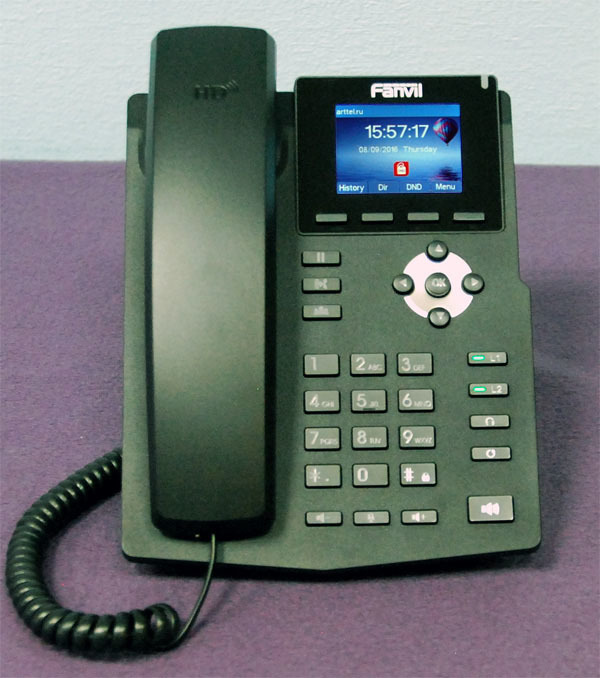
More immediately striking is the fact that the case of Fanvil X3S is extremely narrow. On the one hand, this is good: the less space the phone takes in the workplace, the better. On the other hand, because of this decision, we had to sacrifice the size of the keys and their location. If manufacturers usually try to place all the function keys more or less in one place, then they are scattered across the front panel. However, you can quickly get used to it. But it’s harder to get used to the small and tightly located keys of the dialer - getting into them without looking will not work, you need to do it with concentration. But they were pleased with the navigation keys - it's not only convenient to use them, but also extremely pleasant, thanks to the highly rounded shape.
The Fanvil X3S tube is very similar in its design to the Yealink IP phones of the fortieth series: the same flat, with a very compact bottom and a rather massive top. At first, it is inconvenient to use such a tube, as it cannot be wrapped around the whole five because of a very small bend (the knuckles rest on the cheek). But it is necessary to slightly change the grip, putting your index finger along the tube, as soon as everything falls into place. In this position, the tube, due to proper weight distribution, is pretty confident. And thanks to the massive upper part, the ear feels comfortable even during a long telephone conversation.

Separately, it is worth noting the following nuance: the Fanvil X3S phone supports mounting on the wall. As a rule, in such cases, manufacturers equip the seats of the tube retractable or rotary lever for its fixation with vertical mounting. The Fanvil X3S also has such a lever, but it is fixed, that is, if you install it on the table, it will not work. Whether it’s an advantage or a disadvantage is a matter of taste. I used to pick up the phone carelessly, just pulling it towards me. To do this, the retainer interferes - first you need to lift the tube and only then pull it towards you. Therefore, for me the presence of a fixed tongue is rather a disadvantage. On the other hand, customers often heard that the handset should fit securely in the seat, which is exactly the case.

The main difference between the Fanvil X3S and the previous X3 model is the color display. It is relatively small - 2.4 inches with a resolution of 320 by 240 pixels, but in comparison with the monochrome display, the X3 is a big step forward in terms of comfort with the phone. The colors are quite bright, the information from the display is read well, working with settings, the phone book, call history has become much more convenient.
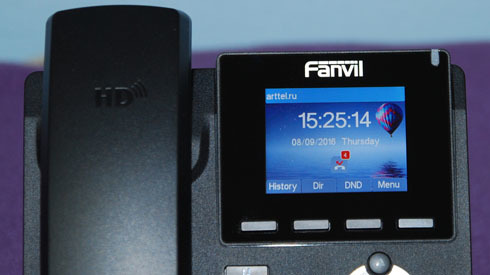

There are small complaints about the graphical interface: if the home screen page looks great, then you can still work with other pages. It is about the used background, and about fonts, and about icons, and about the general layout. What is now does not cause any rejection, but there is a feeling that all this may look much better. There is also a lack of adjustment of brightness and contrast - on a bright sunny day this may be required.
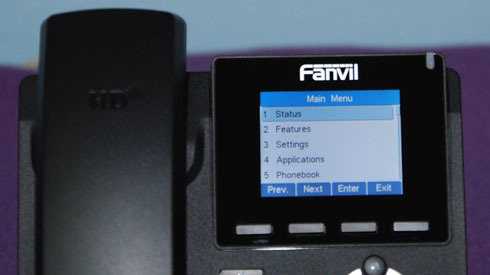

The ports on the Fanvil X3S are the most common — two network ports, a 4P4C jack for connecting a handset, and a similar headset jack. Let me remind you again: the X3S and X3SP models have one hundred-megabit network ports, while the X3G model has gigabit ports. The X3SP and X3G models support PoE, the youngest Fanvil X3S does not.
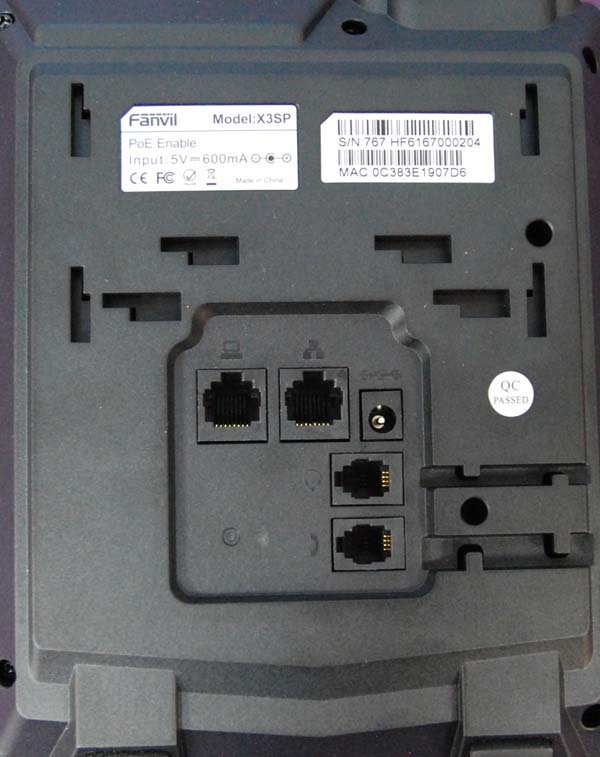
The phone is based on a 275 MHz Broadcom BCM1190KQMG MIPS processor and is equipped with 128 megabytes of RAM. The time for the phone to fully load from power on to registration is 35 seconds. Budget Grandstream phones and Yealink, which use a different type of chip - ARM-processor DSPG DVF9918 - loads about the same. While running the Fanvil X3S, there is no shortage of performance in any way - everything works stably and fairly quickly.
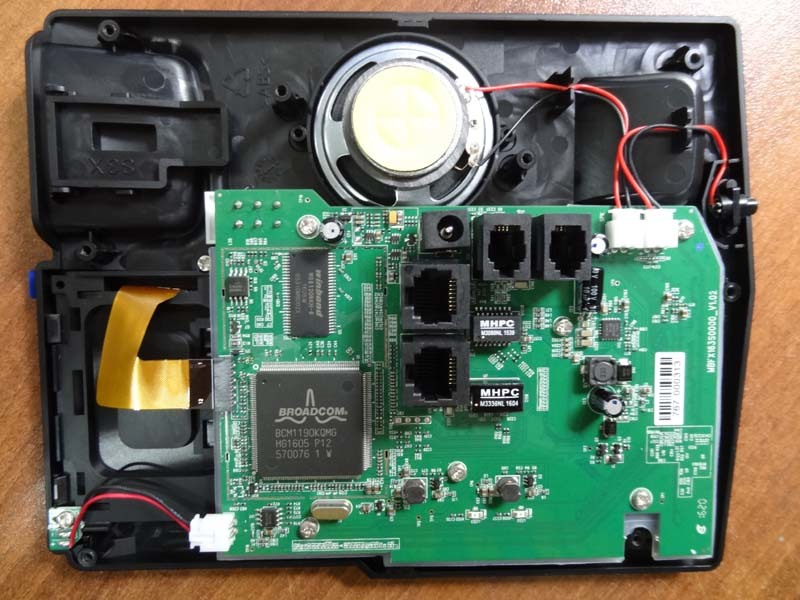
On the handset Fanvil X3S, as well as on the vast majority of all modern IP phones, the inscription "HD" proudly flaunts. The correct translation of this phrase is as follows: the phone (or rather, the chip on which the phone is built) supports the G.722 wideband codec and nothing more. Meanwhile, the sound quality is much more dependent on the design of the tube and the quality of the speakers used. Since these components are also unified to a certain extent, the sound quality of all modern devices is about the same. Fanvil X3S is not an exception - to talk on it is quite comfortable, the sound is moderately deep and rich.
Unfortunately, the same cannot be said about the quality of the speakerphone - it is very mediocre. When playing a speech, the sound is quite dirty, with a clear rattling. It’s not worth talking about music - when playing through the Fanvil X3S speakerphone, it turns into a mess, which, to be frank, especially uncomfortable to listen to, is unpleasant to listen to. So, I would not recommend to make calls in a hands-free mode to any call-center with a long waiting time. The reason for such a low level of speakerphone lies in the extremely compact size of Fanvil X3S. We recently wrote about how the ATCOM engineers managed to achieve excellent communication quality, I think Fanvil should learn from their neighbors a positive experience.
But Fanvil X3S is doing well in terms of network capabilities. Two network ports support bridging, and you can use static IP, DHCP, or PPPoE to connect to the network. For large companies, the ability to allocate phones in a separate VLAN will be extremely useful, and traffic prioritization using QoS is also supported. The support of the 802.1x standard for authenticating users and devices in a data network looks quite interesting. The phone also has a built-in LLDP agent, which simplifies its monitoring and allows you to build network maps.
IP phones are often installed in facilities remote from the main office - in warehouses, retail outlets, in small branches. In this case, the phone’s support for VPN protocols becomes quite a significant parameter. Fanvil X3S works with both L2TP and OpenVPN, but you have to be careful - in firmware designed for the Russian market, this functionality may be removed in the future.
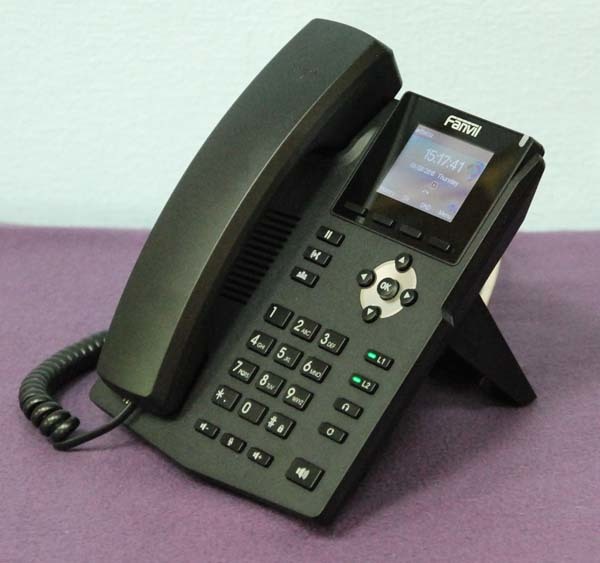
Fanvil X3S IP phone supports work with two independent SIP accounts. In recent years, the company has been actively certifying its phones to work with various IP PBXs, such as Asterisk, Elastix, Broadsoft, 3CX, Yeastar, Zycoo, Matrix, Epygi, Gaoke, and others. All functions supported by the phone are, in general, standard - transfer, hold, wait, call forwarding. Automatic dialing and auto answer, conference call, voice mail, DND mode, blacklist, microphone mute - all these functions are there, and it is quite convenient to use them.
We should also mention the phone book: a local directory of 500 numbers is built into the phone. You can also tie up to 8 remote phonebooks in XML format, or you can set up interaction with the LDAP directory.
Fanvil X3S supports three configuration methods. The basic setting can be made via the on-screen menu, and the full setting via the phone’s web interface. Automatic configuration via FTP, TFTP, HTTP and HTTPS is also possible. Attention is drawn to the large number of built-in diagnostic tools. If Syslog support and the ability to make a traffic dump are pretty familiar, sending ICMP packets directly from the on-screen menu, as well as a tool for saving screenshots in the web interface, is not found in every phone. By the way, to enter the Web-interface, it is not necessary to manually type the IP-address of the phone in the address bar of the browser. Instead, you can scan the QR code from the phone screen and get there automatically. Surprisingly, the Web-interface is even adapted to work with mobile devices.
Another nice feature of the web interface is the ability to manage phone calls directly from it. Only the three most simple functions are supported - dialing, answering a call and ending it. Of course, such functionality cannot compete with full-fledged CTI-applications, but many competitors do not even have this.

This is not to say that Fanvil X3S made a strong and unusual impression. This is quite an ordinary phone with its strengths and weaknesses. But it is important to note this: at the moment, the most affordable IP phone with a color display is the Grandstream GXP2130, the retail price of which is about $ 105. Unfortunately, while there is no exact information about how much a new device from Fanvil will cost, but with a very high probability we can assume that it will be cheaper. And this is not only a good opportunity for consumers to buy a quality IP phone with a color display for little money, but also a signal to other manufacturers: it’s time to stop considering the color screen as an attribute of premium IP phones only, after all 2016 is the year.

In fact, the update is not limited to the release of one new model. Together with the usual X3S, a modification with PoE - X3SP is also released. Another model - X3G - in addition to supporting PoE and Gigabit Ethernet, will also have a slightly larger display (2.8 inches vs. 2.4 for the first two models). Toward the end of the year, the brand new Fanvil X4 (G) and Fanvil X6 phones are expected to be released, as well as an update of the X5 model. However, everything has its time and we will definitely tell about these phones separately, and today - all the attention of Fanvil X3S.
Design and ergonomics
Fanvil X3S is made in the fashionable style today - the body of dark matte plastic and black glossy edging around the display. This is exactly what almost all modern IP phones produced by Yealink and Grandstream look like, it was not for nothing that I mentioned them at the beginning of the article. However, this style has not yet had time to pall, besides, the designers of Fanvil have added a bit of novelty, almost completely eliminating the white color from the design - even the signatures of the keys are made in light gray. Well, let the Fanvil X3S not differ originality, which has always highlighted the C-series phones, but the device looks, in my opinion, quite nice and concise.

More immediately striking is the fact that the case of Fanvil X3S is extremely narrow. On the one hand, this is good: the less space the phone takes in the workplace, the better. On the other hand, because of this decision, we had to sacrifice the size of the keys and their location. If manufacturers usually try to place all the function keys more or less in one place, then they are scattered across the front panel. However, you can quickly get used to it. But it’s harder to get used to the small and tightly located keys of the dialer - getting into them without looking will not work, you need to do it with concentration. But they were pleased with the navigation keys - it's not only convenient to use them, but also extremely pleasant, thanks to the highly rounded shape.
A tube
The Fanvil X3S tube is very similar in its design to the Yealink IP phones of the fortieth series: the same flat, with a very compact bottom and a rather massive top. At first, it is inconvenient to use such a tube, as it cannot be wrapped around the whole five because of a very small bend (the knuckles rest on the cheek). But it is necessary to slightly change the grip, putting your index finger along the tube, as soon as everything falls into place. In this position, the tube, due to proper weight distribution, is pretty confident. And thanks to the massive upper part, the ear feels comfortable even during a long telephone conversation.

Separately, it is worth noting the following nuance: the Fanvil X3S phone supports mounting on the wall. As a rule, in such cases, manufacturers equip the seats of the tube retractable or rotary lever for its fixation with vertical mounting. The Fanvil X3S also has such a lever, but it is fixed, that is, if you install it on the table, it will not work. Whether it’s an advantage or a disadvantage is a matter of taste. I used to pick up the phone carelessly, just pulling it towards me. To do this, the retainer interferes - first you need to lift the tube and only then pull it towards you. Therefore, for me the presence of a fixed tongue is rather a disadvantage. On the other hand, customers often heard that the handset should fit securely in the seat, which is exactly the case.

Screen
The main difference between the Fanvil X3S and the previous X3 model is the color display. It is relatively small - 2.4 inches with a resolution of 320 by 240 pixels, but in comparison with the monochrome display, the X3 is a big step forward in terms of comfort with the phone. The colors are quite bright, the information from the display is read well, working with settings, the phone book, call history has become much more convenient.


There are small complaints about the graphical interface: if the home screen page looks great, then you can still work with other pages. It is about the used background, and about fonts, and about icons, and about the general layout. What is now does not cause any rejection, but there is a feeling that all this may look much better. There is also a lack of adjustment of brightness and contrast - on a bright sunny day this may be required.


Ports and iron
The ports on the Fanvil X3S are the most common — two network ports, a 4P4C jack for connecting a handset, and a similar headset jack. Let me remind you again: the X3S and X3SP models have one hundred-megabit network ports, while the X3G model has gigabit ports. The X3SP and X3G models support PoE, the youngest Fanvil X3S does not.

The phone is based on a 275 MHz Broadcom BCM1190KQMG MIPS processor and is equipped with 128 megabytes of RAM. The time for the phone to fully load from power on to registration is 35 seconds. Budget Grandstream phones and Yealink, which use a different type of chip - ARM-processor DSPG DVF9918 - loads about the same. While running the Fanvil X3S, there is no shortage of performance in any way - everything works stably and fairly quickly.

Sound quality
On the handset Fanvil X3S, as well as on the vast majority of all modern IP phones, the inscription "HD" proudly flaunts. The correct translation of this phrase is as follows: the phone (or rather, the chip on which the phone is built) supports the G.722 wideband codec and nothing more. Meanwhile, the sound quality is much more dependent on the design of the tube and the quality of the speakers used. Since these components are also unified to a certain extent, the sound quality of all modern devices is about the same. Fanvil X3S is not an exception - to talk on it is quite comfortable, the sound is moderately deep and rich.
Unfortunately, the same cannot be said about the quality of the speakerphone - it is very mediocre. When playing a speech, the sound is quite dirty, with a clear rattling. It’s not worth talking about music - when playing through the Fanvil X3S speakerphone, it turns into a mess, which, to be frank, especially uncomfortable to listen to, is unpleasant to listen to. So, I would not recommend to make calls in a hands-free mode to any call-center with a long waiting time. The reason for such a low level of speakerphone lies in the extremely compact size of Fanvil X3S. We recently wrote about how the ATCOM engineers managed to achieve excellent communication quality, I think Fanvil should learn from their neighbors a positive experience.
Work with network
But Fanvil X3S is doing well in terms of network capabilities. Two network ports support bridging, and you can use static IP, DHCP, or PPPoE to connect to the network. For large companies, the ability to allocate phones in a separate VLAN will be extremely useful, and traffic prioritization using QoS is also supported. The support of the 802.1x standard for authenticating users and devices in a data network looks quite interesting. The phone also has a built-in LLDP agent, which simplifies its monitoring and allows you to build network maps.
IP phones are often installed in facilities remote from the main office - in warehouses, retail outlets, in small branches. In this case, the phone’s support for VPN protocols becomes quite a significant parameter. Fanvil X3S works with both L2TP and OpenVPN, but you have to be careful - in firmware designed for the Russian market, this functionality may be removed in the future.

Standard features
Fanvil X3S IP phone supports work with two independent SIP accounts. In recent years, the company has been actively certifying its phones to work with various IP PBXs, such as Asterisk, Elastix, Broadsoft, 3CX, Yeastar, Zycoo, Matrix, Epygi, Gaoke, and others. All functions supported by the phone are, in general, standard - transfer, hold, wait, call forwarding. Automatic dialing and auto answer, conference call, voice mail, DND mode, blacklist, microphone mute - all these functions are there, and it is quite convenient to use them.
We should also mention the phone book: a local directory of 500 numbers is built into the phone. You can also tie up to 8 remote phonebooks in XML format, or you can set up interaction with the LDAP directory.
Setup and Management
Fanvil X3S supports three configuration methods. The basic setting can be made via the on-screen menu, and the full setting via the phone’s web interface. Automatic configuration via FTP, TFTP, HTTP and HTTPS is also possible. Attention is drawn to the large number of built-in diagnostic tools. If Syslog support and the ability to make a traffic dump are pretty familiar, sending ICMP packets directly from the on-screen menu, as well as a tool for saving screenshots in the web interface, is not found in every phone. By the way, to enter the Web-interface, it is not necessary to manually type the IP-address of the phone in the address bar of the browser. Instead, you can scan the QR code from the phone screen and get there automatically. Surprisingly, the Web-interface is even adapted to work with mobile devices.
Another nice feature of the web interface is the ability to manage phone calls directly from it. Only the three most simple functions are supported - dialing, answering a call and ending it. Of course, such functionality cannot compete with full-fledged CTI-applications, but many competitors do not even have this.

findings
This is not to say that Fanvil X3S made a strong and unusual impression. This is quite an ordinary phone with its strengths and weaknesses. But it is important to note this: at the moment, the most affordable IP phone with a color display is the Grandstream GXP2130, the retail price of which is about $ 105. Unfortunately, while there is no exact information about how much a new device from Fanvil will cost, but with a very high probability we can assume that it will be cheaper. And this is not only a good opportunity for consumers to buy a quality IP phone with a color display for little money, but also a signal to other manufacturers: it’s time to stop considering the color screen as an attribute of premium IP phones only, after all 2016 is the year.
